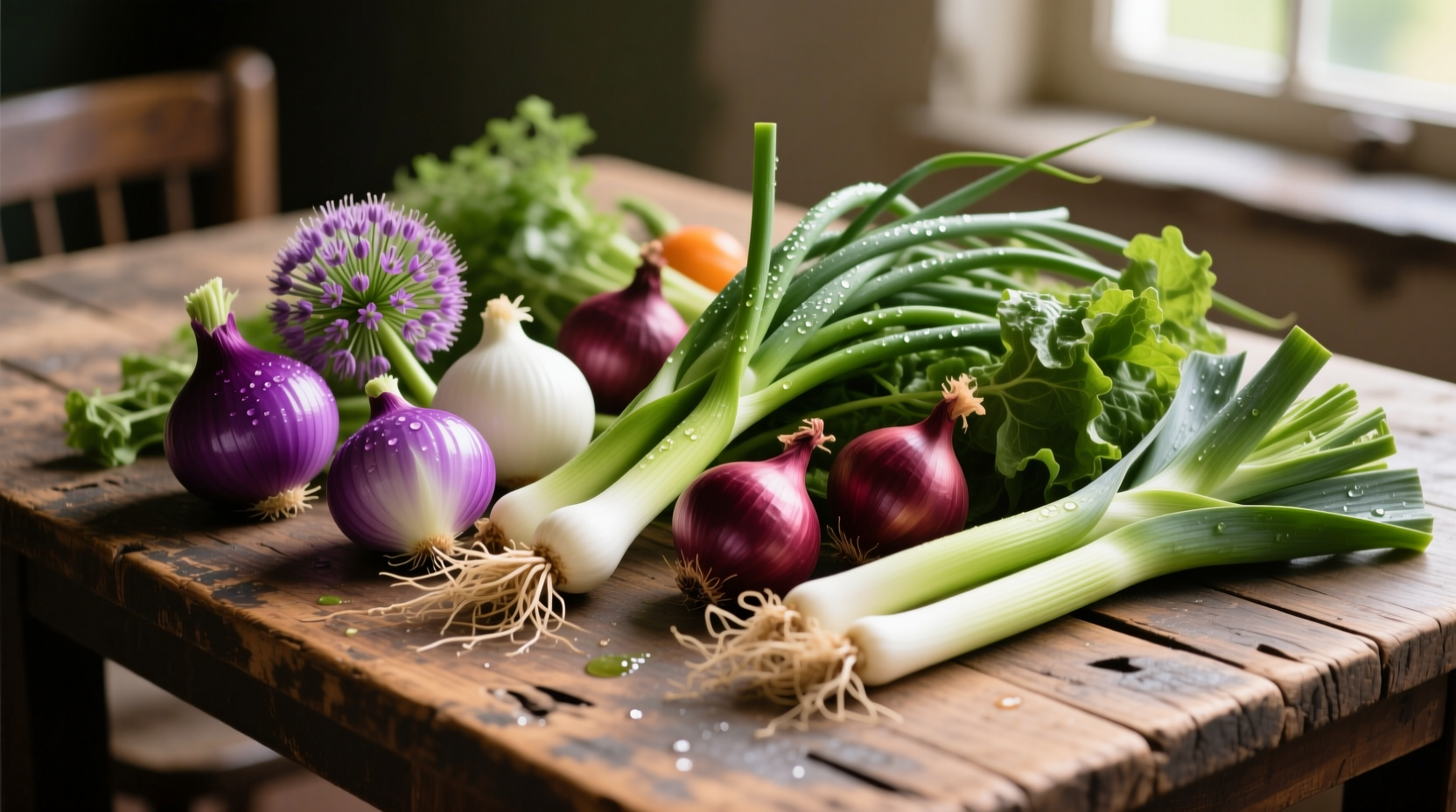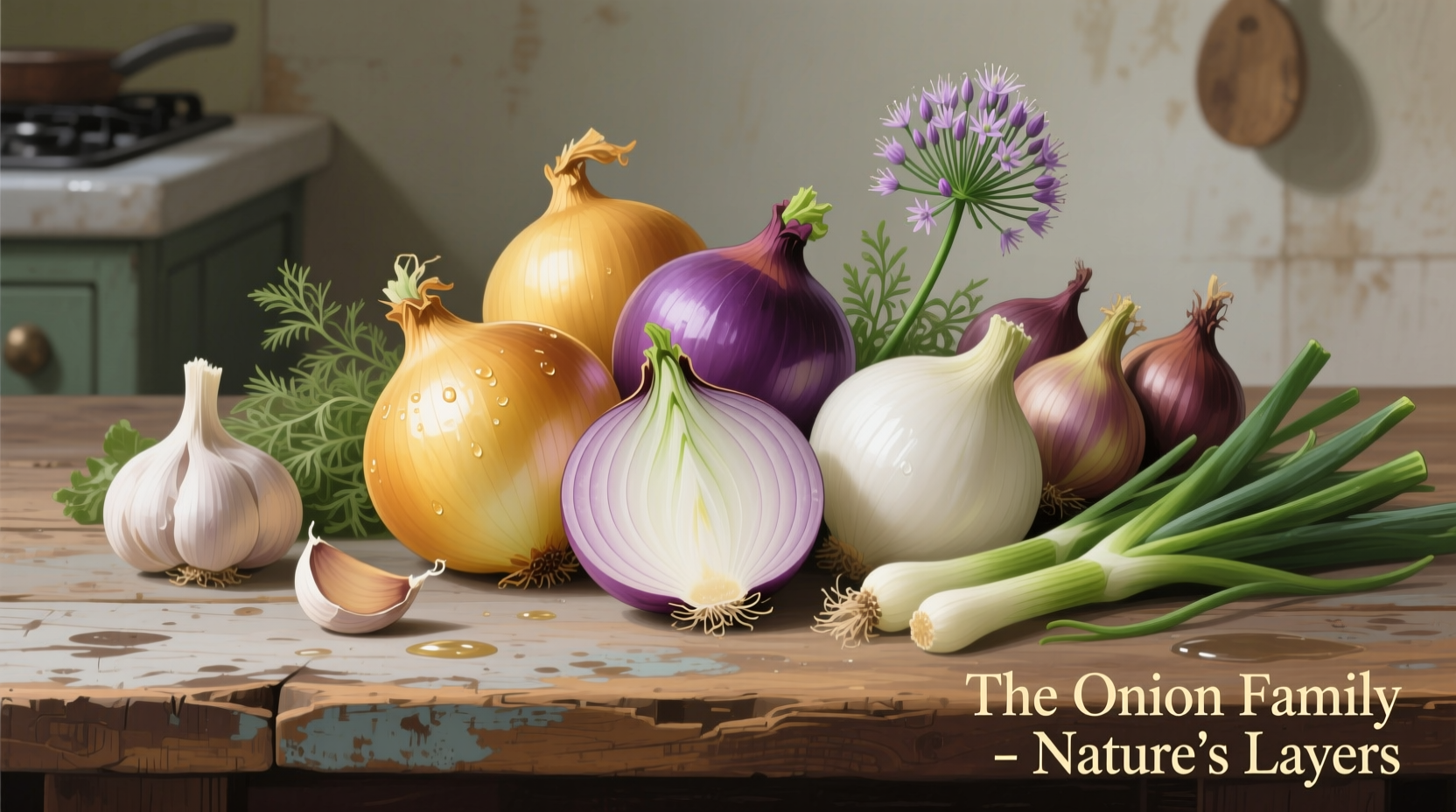Unlock the culinary and nutritional power of the allium family with this comprehensive guide. Whether you're a home cook seeking flavor mastery, a gardener planning your next crop, or someone interested in plant-based nutrition, you'll discover exactly how these versatile vegetables can transform your meals and support your wellbeing. We've distilled decades of botanical research and culinary expertise into actionable insights you can use immediately.
What Exactly Is the Onion Family?
The onion family, or Allium genus, represents one of the most valuable plant groups for human consumption. With over 850 species worldwide, these bulbous vegetables share distinctive sulfur-containing compounds that create their characteristic pungency and therapeutic properties. Unlike many vegetable families, alliums deliver both immediate culinary impact and long-term health benefits through their unique phytochemical profile.
Botanically classified under the Amaryllidaceae family, allium vegetables have been cultivated for more than 5,000 years. Ancient Egyptians revered onions as symbols of eternity, while traditional Chinese medicine has utilized garlic for centuries to support cardiovascular health. This historical significance reflects the enduring value these plants provide across cultures.
Allium Family Members: Identification and Characteristics
Understanding the specific members of the onion family helps you select the right variety for your culinary or gardening needs. Each allium vegetable offers distinct flavor profiles and growing requirements that affect how you should use them.
| Vegetable | Flavor Profile | Best Culinary Uses | Seasonality |
|---|---|---|---|
| Yellow Onions | Strong, pungent when raw; sweet when cooked | General cooking, caramelizing, roasting | Year-round (peak summer-fall) |
| Garlic | Intensely pungent when raw; nutty and mellow when roasted | Flavor base for sauces, marinades, roasted dishes | Year-round (fresh garlic spring-summer) |
| Leeks | Mild, sweet onion flavor | Soups, stews, sautés, gratins | Winter-spring |
| Chives | Delicate onion flavor with grassy notes | Garnishes, egg dishes, potato toppings | Spring-summer |
| Shallots | Subtle garlic-onion hybrid, sweet when cooked | Vinaigrettes, sauces, delicate dishes | Fall-winter |
Nutritional Powerhouse: The Science-Backed Benefits
Allium vegetables deliver remarkable nutritional density. According to USDA FoodData Central, a single cup of chopped onions provides 13.11g of carbohydrates, 2.72g of fiber, and significant amounts of vitamin C (11.8mg), vitamin B6 (0.27mg), and manganese (0.18mg). But their true value lies in specialized compounds like allicin and quercetin.
Research published in the Journal of Agricultural and Food Chemistry confirms that these sulfur compounds demonstrate potent antioxidant and anti-inflammatory effects. When you chop or crush allium vegetables, the enzyme alliinase converts precursor compounds into active phytochemicals. This explains why freshly prepared garlic offers greater health benefits than pre-minced varieties.
For cardiovascular health, a comprehensive review in Nutrients (2020) found that regular allium consumption correlates with reduced blood pressure and improved cholesterol profiles. The World Health Organization recognizes garlic's traditional use for managing mild hypertension, noting its potential as a complementary approach to cardiovascular support.

Culinary Applications: Maximizing Flavor and Nutrition
Professional chefs understand that how you handle allium vegetables dramatically affects both flavor and nutritional value. The key lies in managing the enzymatic reactions that occur when cells are damaged through cutting or crushing.
For maximum health benefits, let chopped garlic sit for 10 minutes before cooking. This allows complete conversion of alliin to allicin, the compound responsible for many of garlic's therapeutic effects. When cooking onions, remember that longer cooking times increase sweetness through caramelization but reduce certain heat-sensitive compounds.
Consider these practical applications:
- Raw applications: Use milder alliums like scallions or chives in salads and garnishes where their delicate flavor shines
- Sweating technique: Cook onions over medium-low heat with a small amount of fat until translucent (8-10 minutes) to build flavor foundations without browning
- Caramelization: Cook onions slowly over low heat for 30-40 minutes to develop complex sweetness through the Maillard reaction
- Roasting: Whole garlic cloves roasted with olive oil become sweet and spreadable, perfect for bread or sauces
Growing Your Own Allium Family: Essential Tips
Gardeners appreciate alliums for their relative ease of cultivation and pest-repelling properties. According to the USDA Plant Hardiness Zone Map, most allium varieties thrive in zones 3-10, making them suitable for diverse climates.
For successful cultivation:
- Plant onion sets or seeds in early spring as soon as soil can be worked
- Provide full sun (6-8 hours daily) and well-draining soil
- Maintain consistent moisture, especially during bulb formation
- Rotate crops annually to prevent soil-borne diseases
- Harvest garlic when lower leaves begin to yellow (typically mid-summer)
Notably, alliums serve as excellent companion plants. Their strong scent deters many common garden pests, making them valuable neighbors for strawberries, tomatoes, and carrots. However, avoid planting them near legumes like beans and peas, as they can inhibit each other's growth.
Storage Secrets for Maximum Freshness
Proper storage dramatically extends the shelf life of allium vegetables. The National Onion Association recommends storing dry bulb onions in a cool, dry, dark place with good air circulation. Never refrigerate whole onions, as moisture promotes spoilage.
For optimal longevity:
- Store whole onions: 2-3 months in mesh bags in a cool, dark pantry
- Store garlic: 3-6 months in open containers at room temperature
- Store leeks: Wrapped in damp paper towels in refrigerator crisper (1-2 weeks)
- Store scallions: Roots submerged in water on kitchen counter (change water daily)
- Freeze chopped onions: Spread on baking sheet, freeze, then transfer to airtight container (6-8 months)
Common Mistakes to Avoid
Even experienced cooks sometimes mishandle allium vegetables. Understanding these common pitfalls helps you maximize both flavor and nutrition:
- Overcooking garlic: High heat destroys delicate compounds and creates bitterness. Add minced garlic during the last 1-2 minutes of cooking
- Using the wrong variety: Strong yellow onions overwhelm delicate dishes where shallots or scallions would be better
- Improper storage: Storing onions and potatoes together accelerates spoilage of both (they emit gases that affect each other)
- Discarding edible parts: Leek greens and scallion tops contain valuable nutrients—chop finely for soups or stocks
Health Considerations and Allergies
While generally safe, allium vegetables can cause issues for some individuals. The FODMAP content in onions and garlic may trigger digestive discomfort in people with irritable bowel syndrome. According to Monash University's low-FODMAP research, green onion tops and chives typically contain lower FODMAP levels than bulb portions.
Additionally, some people experience contact dermatitis from handling garlic or onions. Wearing gloves during preparation can prevent this reaction. If you take blood-thinning medications, consult your healthcare provider about consuming large amounts of garlic, as it may enhance medication effects.











 浙公网安备
33010002000092号
浙公网安备
33010002000092号 浙B2-20120091-4
浙B2-20120091-4